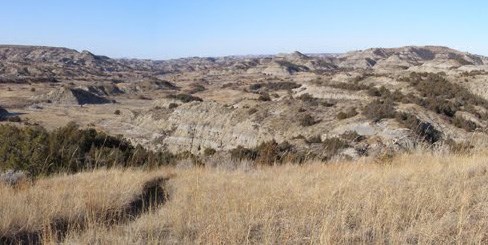
Nathan King Battle of the Badlands Sully rejoined with 800 of his troops he had left guarding an emigrant wagon train at the Heart River and continued west with his full complement of 3,000, reaching the edge of the badlands on August 5, 1864. Knowing that supplies were waiting for him along the Yellowstone River beyond the badlands, Sully led his troops into the rough terrain of steep, clay buttes. Sioux warriors attacked Sully’s encampment near Square Butte, halfway between present-day Medora and Sentinel Butte, ND on August 7. Continuous small-scale combat continued over the next two days as the Sioux harassed the slow-moving, extended column of troops winding through the labyrinthine badlands. Sully claimed 100 warriors killed and suffered 9 dead and 100 wounded of his own over three days of fighting in the badlands. Sully exited the badlands and reached the Yellowstone River on August 10, where steamboats were waiting with supplies. His unit later proceeded to Fort Union, then to Fort Rice. After pushing the Sioux into Montana, Sully discontinued his pursuit. Fanny Kelly lamented, “I had so hoped for liberty when my friends were near; but alas! all my fond hopes were blasted.” Kelly was not freed for several more months, enduring hardship and starvation alongside the Sioux, and constant fear that she would be executed by her captors. Sitting Bull, who had not been responsible for her capture, helped arrange for her return, reportedly saying, “Friends, this woman is out of our path. Her path is different. You can see in her face that she is homesick and unhappy here. So I am going to send her back.” Sitting Bull’s compassion was noted by his people; the winter of 1864-65 is known as “The-Winter-When-the-White-Woman-was-Rescued” on the Hunkpapa Sioux calendar. Kelly published a memoir of her experience with the Sioux in 1871. In September 1864, a group of Hunkpapa Sioux led by Sitting Bull attacked stragglers in an emigrant wagon train protected by U.S. Cavalry under Captain James Fisk near modern Marmarth, ND. Some of the cavalry turned back to assist, but were too late to save the soldiers that had been attempting to right an overturned wagon when the group of warriors including Sitting Bull attacked. Jefferson Dilts, a cavalry scout, charged the warriors, killing up to six Hunkpapas. Dilts took three arrows in the back while attempting to escape; he was killed. Sitting Bull was wounded in the left hip in the fighting. Fisk and his men dug in and found themselves trapped until they were rescued by 900 troops sent by General Sully after his return to Fort Rice. Thus, major hostilities in western North Dakota ended. General Sully did not attempt to wage another campaign against the Sioux in 1865; operations in 1864 had not weakened the Sioux’s resolve. Moreover, the warfare had cost the U.S. Government $40 million, and some thought that peace would be a less expensive policy. Indeed, peace was President Ulysses S. Grant’s policy from 1869 to 1874. The Peace Policy ended when unrest on the Southern Great Plains induced the Cheyenne, Kiowa, and Comanche to rebel starting the The Red River War. On the Northern Great Plains, little changed in the years following Sully’s 1864 campaign. Some Sioux collected annuities and lived on reservations, others lived on their hunting grounds in the traditional way of life, and still others alternated between the two lifestyles for the time being. |
Last updated: April 10, 2015
